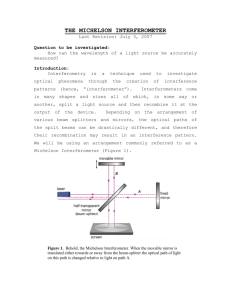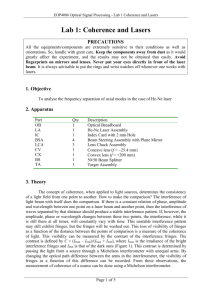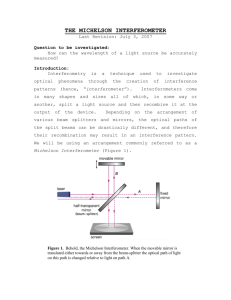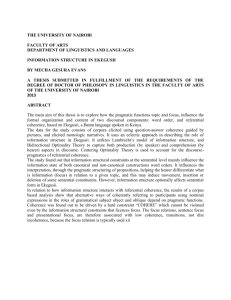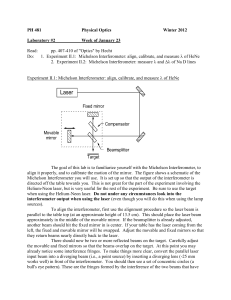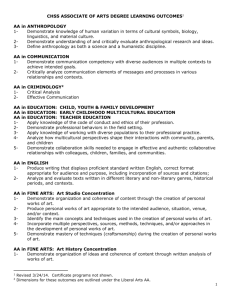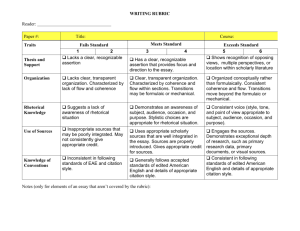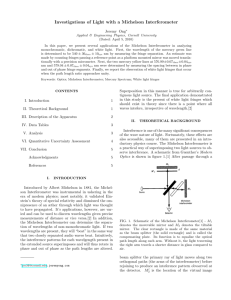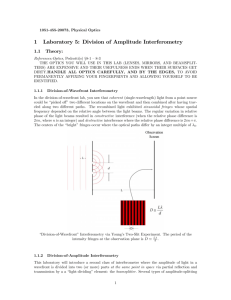exp2-R1
advertisement
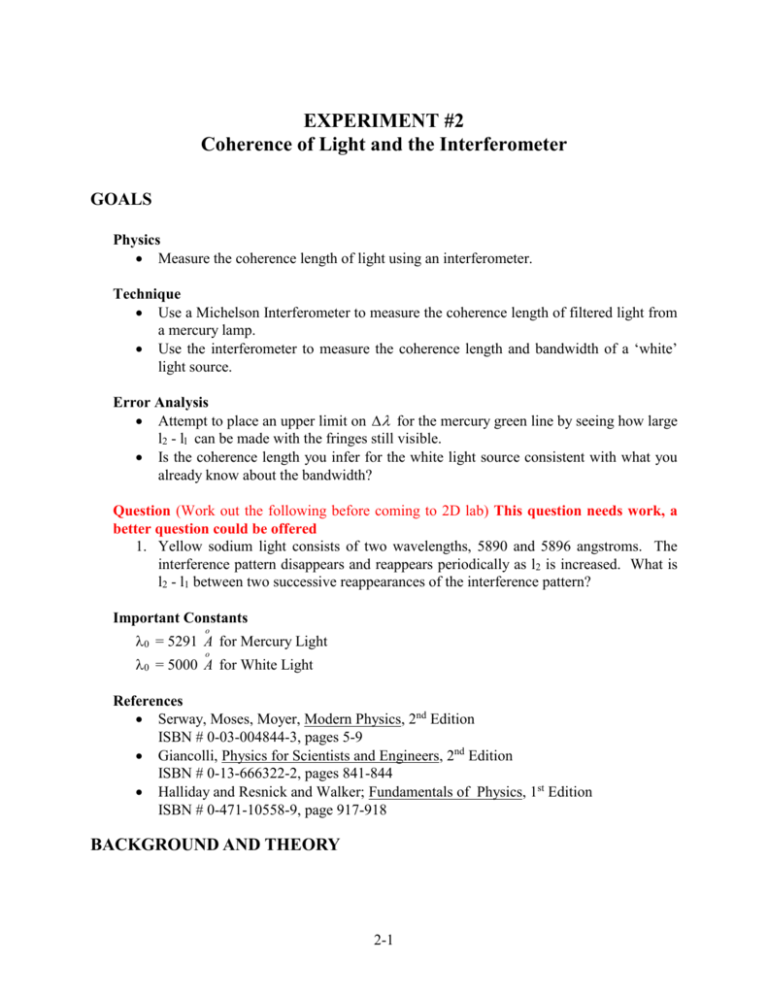
EXPERIMENT #2 Coherence of Light and the Interferometer GOALS Physics Measure the coherence length of light using an interferometer. Technique Use a Michelson Interferometer to measure the coherence length of filtered light from a mercury lamp. Use the interferometer to measure the coherence length and bandwidth of a ‘white’ light source. Error Analysis Attempt to place an upper limit on for the mercury green line by seeing how large l2 - ll can be made with the fringes still visible. Is the coherence length you infer for the white light source consistent with what you already know about the bandwidth? Question (Work out the following before coming to 2D lab) This question needs work, a better question could be offered 1. Yellow sodium light consists of two wavelengths, 5890 and 5896 angstroms. The interference pattern disappears and reappears periodically as l2 is increased. What is l2 - l1 between two successive reappearances of the interference pattern? Important Constants o 0 = 5291 A for Mercury Light o 0 = 5000 A for White Light References Serway, Moses, Moyer, Modern Physics, 2nd Edition ISBN # 0-03-004844-3, pages 5-9 Giancolli, Physics for Scientists and Engineers, 2nd Edition ISBN # 0-13-666322-2, pages 841-844 Halliday and Resnick and Walker; Fundamentals of Physics, 1st Edition ISBN # 0-471-10558-9, page 917-918 BACKGROUND AND THEORY 2-1 In this experiment, we shall be concerned with light that is not strictly monochromatic (as is laser light), but rather consists of a mixture of wavelengths. Indeed, until the 1960’s when the laser was invented, no perfectly monochromatic light had ever been seen or generated. Even the purest ordinary single-color sources (radiating atoms, for example) emit light that contains a spread of wavelengths. A property of light that is directly related to its monochromaticity is its coherence. The degree of coherence of a source of light is the degree to which that light consists of long, unbroken trains of sinusoidal waves. Suppose we have a train of pure sine waves with wavelength 0 having some total length in space, and propagating at velocity c. Figure 1 Mathematically, we might express this train in terms of the field seen by a stationary observer as the waves pass by: E(t ) Eo sin wot , for 0 < t < c = 0 for t < 0 , or for t > . c Now, we may inquire as to the frequencies present in this wave. Superficially, one might guess that here, we have only one frequency, wo, since the above equation seems to imply just that. This guess would be wrong, however, because the wave packet turns on and turns off, i.e., is not continuously oscillating. The mathematical technique known as Fourier analysis deals directly with this problem. If we consider any arbitrary function f(t), Fourier analysis shows us that it can be represented as a sum of simple trigonometric sine or cosine functions of different frequencies and different strengths. In particular, the Fourier Integral Transform takes our function f(t) and 2-2 converts it to a function g(w) representing the strength of various frequencies in our original f(t) . The simplest example is an infinitely long train of waves, i.e. f (t) E0 sin w0t , for t . For this case, g(w) is a "delta function", i.e., a single infinitely narrow peak at w = wo , with no contribution anywhere else, indicating that here, there is indeed only one frequency (Fig. 2). Figure 2 , we discover c that a band of frequencies of width w has appeared in g(w) , centered at wo (Fig. 3). However, when we Fourier transform our short wave train of length t 2-3 Figure 3 A general result, whose accuracy is sufficient for our needs here, is that a wave train of frequency wo , truncated to a duration has its frequency spectrum spread over a range w , such that w 2 . Thus, a short wave "packet" contains a wide spread of frequencies, and a long packet has a narrow frequency spectrum. This relation can also be cast in terms of the length x of the packet and the corresponding spread of wavelengths around the central wavelength 0. Since wo 2c , o and c , we have w 2c 2 o . 2 , c 2-4 or, 0 0 1 . The spread of wavelengths is also called the bandwidth, and the packet length is also called the coherence length. THE MICHELSON INTERFEROMETER The interferometer measures the coherence of light by making the light “interfere” with itself. A beam of light is passed through a partially transparent mirror, or "beamsplitter", so that every train of waves in the beam is split into two identical trains, each having half of the original intensity. Each wave train is sent along a separate path, after which the waves are again recombined. The two components will interfere destructively or interfere constructively, depending upon whether the difference in the path lengths is an even or odd number of half-wavelengths. The Michelson interferometer, which we will use in this experiment, can be schematically described by the following figure: Figure 4 Part of the incoming beam reflects off mirror B and travels path length l2 to mirror M2 and back; the waves-train which passes through B has path length l1. Some of each wave-train then travels to the eye. The eye will see darkness if l 2 l1 (n 1/ 2)o , and a bright light if 2-5 l 2 l1 no . A quite special situation arises, however, if we assume finite coherence length, i.e., partial coherence of the light. First, consider the case where (l1 and l2). The beam consists of a random flood of wave packets, where all packets are much longer than paths ll and l2. When each packet recombines with its image at the output, it interferes with itself, and destructive or constructive interference will occur depending on l2 - l1. Now, consider the case where < l 2 l1 ; we get the situation in which one portion of the packet is delayed enough so that it fails altogether to overlap its partner at the output, and no interference can occur. That is, interference can not occur with a different wave of different frequency in the next packet. Figure 5 Thus, we have a convenient means of measuring coherence length: begin with l1 = l2, and increase l2 until the alternating interferences become weaker and just disappear. l2 - l1 is then the coherence length x. This is the basic technique for this lab. is measured from center point to one limit rather than from limit end to limit end. 2-6 THIS EXPERIMENT PURPOSE The purpose of this experiment is to study the coherence length and band width of Mercury and White light using a Michelson Interferometer. EXPERIMENTAL SETUP Your instructor will acquaint you with the various components on the base of the instrument. The first mirror has two thumbscrews on the rear of its mount; these adjust the mirror angle so that the necessary condition of near perfect parallelism of the two beams can be achieved. These adjustments will have been set previously for you; don't touch them. The second mirror is adjustable in distance from the beam splitter. You will notice a micrometer driving a lever arm that pushes on the mirror from a point near its fulcrum. The micrometer reading that gives l2 - ll = 0 is marked on the base of the instrument. ** Micrometer Reading vs l ** The “micrometer” dial reads 0.00 to 25.00 millimeters of motion of the round shaft. The micrometer shaft actuates a lever arm which pushes the translation stage carrying the mirror (see Fig. 6 for details on round shaft and lever arm). Two full rotations of the lever arm are equivalent to 1 tic on the shaft. You can verify with a ruler that 20. mm (dial) = 4.0 mm (stage) = 8.0 mm (l). This gives 1 mm (dial on lever arm) = 400. m (l) 1 tic (dial on round shaft) = 4. m (l) or The light source you will use for the first part of the experiment is mounted on a bracket that extends from the main base. It contains two sources, each controllable from the switch box. One is an ordinary white incandescent bulb that emits at all visible wavelengths. The second is a mercury vapor bulb that emits light at a few discrete wavelengths; we say that these are "lines" in the violet, blue, green, and weakly in the yellow. Included also in your equipment are two filters that transmit light over wavelength bands of different width. The green plastic filter transmits a much wider band than the blue filter; you will determine their approximate bandwidths, , in this experiment. 2-7 Filters Light Source Lever Arm Round Shaft Calibration Knobs Figure 6 CAUTION The Michelson Interferometers you will use in this laboratory are precise and expensive research-grade instruments. They must be handled with great care, since the dimensional tolerances that have to be maintained are on the order of a wavelength of light, or a few times 10-5 cm. Be particularly careful not to touch the mirrors or beam splitter. The mirrors are coated on the front surface, so they are particularly susceptible to damage. Be careful not to touch the calibration knobs associated with the first mirror. Moving these knobs will eliminate any visibility to the fringes. PROCEDURE 1. Turn on the mercury lamp, and slip the green filter over its window. The filter will pass the green spectral line while blocking the other lines. The spectral width of the green light that passes through the filter is not determined by the filter, but rather by the mercury atoms themselves, which produce an extremely narrow bandwidth. 2. Assuming that the interferometer is in proper adjustment, you should be able to see in the viewing port a system of vertically oriented stripes, or "fringes". The reason that you see several fringes rather than a uniform illumination over the field of view is that the image of mirror Ml is not exactly parallel to M2 Thus, the difference in path lengths l2 - ll varies from one point in the field to the other. 2-8 3. Ask your TA to make a slight adjustment in the nearest screw on Ml , please do not make these adjustments yourself as you are not yet familiar with the calibration of the machinery. Note that the number of fringes in the field of view can be set to any value you please. 4. Now, with about ten fringes or so in the field, make a slight adjustment of l2 - ll with the micrometer. For each complete fringe that passes a given point in the field, l2 - l1 has changed by . Why does the fringe pattern appear to move across the field? 5. Attempt to place an upper limit on for the mercury green line by seeing how large l2 - ll can be made with the fringes still visible. The upper limit of the fringes is determined by a closed circular fringe. 6. Next, turn on the white light, and remove the green filter. You will see no fringes at all until you adjust l2 - ll to the neighborhood of zero, and then make a very careful search. Go slowly; the few fringes are easy to miss. Determine how large l2 - l1 can be with the fringes still usable. 7. What can you conclude about the coherence length of white light from the fringes you see? Is the coherence length you infer consistent with what you already know about the bandwidth? 8. Place the green filter over the white light, and re-estimate coherence. Notice that visually, the present green light and the mercury line are the same, but that their coherences are very different. 9. Now, substitute the blue filter. Infer its bandwidth from the maximal l2 - l1 for fringes. TROUBLESHOOTING The Mercury light has a very long coherence length which trails off indistinctly; therefore, take note of what you read as the end point and why you chose this as the end point. We recommend the point where one complete circular fringe is visible in the screen. If you cannot see any fringes at all or they are very faint and tiny, ask your TA to adjust the calibrations properly for you. 2-9


